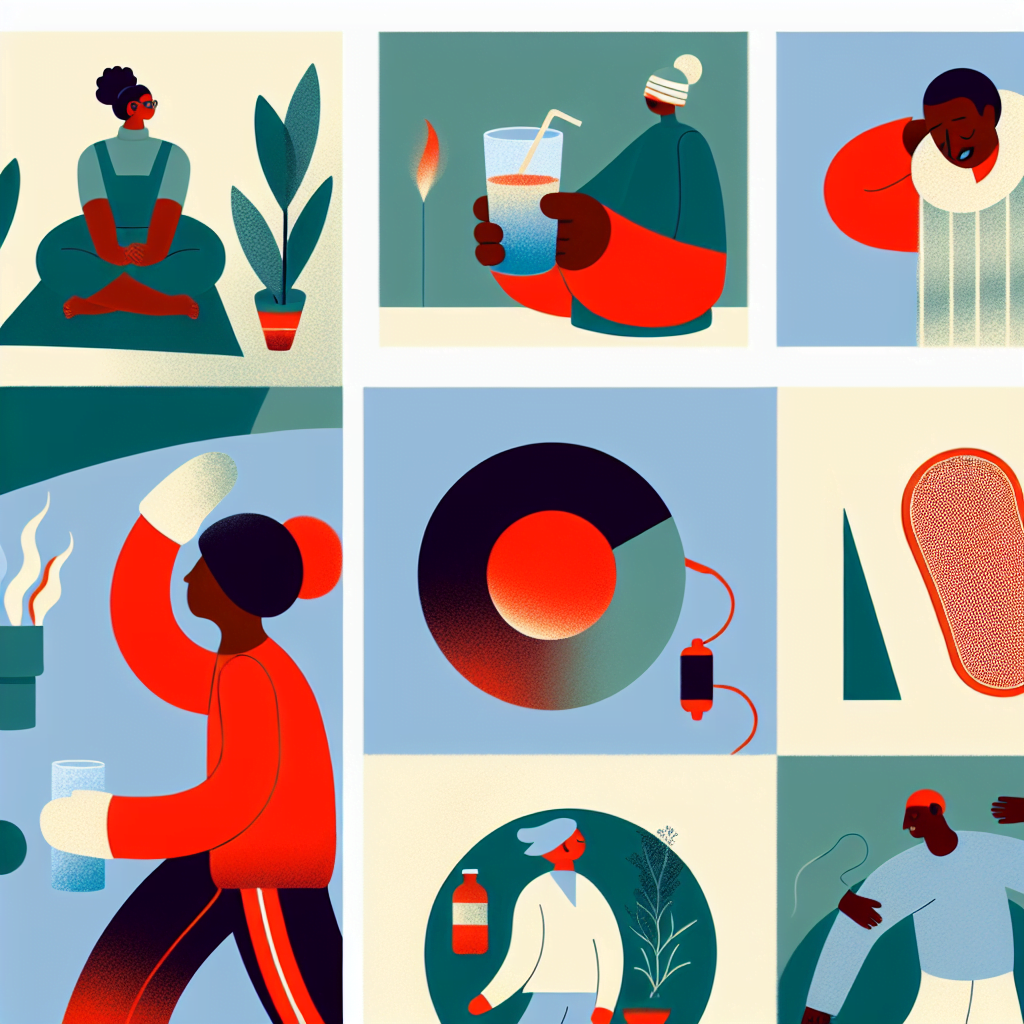Effective Home Remedies for Period Pain Relief
Period pain is something that many women experience on a monthly basis, and it can be incredibly uncomfortable and debilitating. The good news is that there are several effective home remedies that can help alleviate the pain and discomfort associated with menstruation. In this article, we will discuss some tips for getting period pain relief so that you can feel more comfortable and at ease during that time of the month.
One of the most common home remedies for period pain relief is heat therapy. Applying a heating pad or hot water bottle to your lower abdomen can help relax the muscles and reduce cramping. The warmth can also increase blood flow to the area, which can help alleviate pain. Taking a warm bath or shower can also have a similar effect and provide some relief from period pain.
Another effective home remedy for period pain relief is to engage in gentle exercise. While it may be the last thing you feel like doing when you’re in pain, light physical activity such as walking or yoga can help release endorphins, which are natural painkillers. Exercise can also help improve circulation and reduce muscle tension, which can help alleviate period pain.
In addition to heat therapy and exercise, there are several dietary changes that can help alleviate period pain. Eating a diet rich in fruits, vegetables, whole grains, and lean proteins can help reduce inflammation in the body, which can contribute to period pain. Avoiding foods that are high in sugar, caffeine, and processed fats can also help reduce cramping and discomfort during menstruation.
Staying hydrated is another important factor in managing period pain. Drinking plenty of water can help reduce bloating and water retention, which can exacerbate period pain. Herbal teas such as chamomile, ginger, and peppermint can also help soothe cramps and provide relief from period pain.
In addition to these home remedies, there are several over-the-counter medications that can help alleviate period pain. Nonsteroidal anti-inflammatory drugs (NSAIDs) such as ibuprofen can help reduce inflammation and relieve cramping. It’s important to follow the recommended dosage instructions and consult with a healthcare provider if you have any concerns about taking medication for period pain relief.
It’s also important to listen to your body and give yourself permission to rest and relax during your period. Taking time to rest, practice self-care, and engage in activities that bring you joy can help reduce stress and improve your overall well-being during menstruation. Remember that it’s okay to take a break and prioritize your health and comfort during this time.
In conclusion, period pain is a common experience for many women, but there are several effective home remedies that can help alleviate the discomfort and cramping associated with menstruation. Heat therapy, gentle exercise, dietary changes, hydration, and over-the-counter medications can all help provide relief from period pain. It’s important to listen to your body, practice self-care, and prioritize your health and comfort during your period. By incorporating these tips into your routine, you can find relief from period pain and feel more comfortable and at ease during that time of the month.
Best Foods to Eat for Alleviating Menstrual Cramps

Period pain is something that many women experience every month, and it can be incredibly uncomfortable and debilitating. The good news is that there are ways to alleviate this pain, and one of the most effective methods is through diet. By incorporating certain foods into your diet, you can help reduce the severity of your menstrual cramps and make that time of the month a little bit more bearable.
One of the best foods to eat for alleviating menstrual cramps is ginger. Ginger has been used for centuries as a natural remedy for various ailments, including menstrual pain. It has anti-inflammatory properties that can help reduce the inflammation and pain associated with cramps. You can add ginger to your diet by drinking ginger tea, adding fresh ginger to your meals, or taking ginger supplements.
Another great food for relieving period pain is turmeric. Turmeric is a spice that is known for its anti-inflammatory properties, which can help reduce the pain and discomfort of menstrual cramps. You can add turmeric to your meals, drink turmeric tea, or take turmeric supplements to help alleviate your symptoms.
In addition to ginger and turmeric, there are other foods that can help alleviate menstrual cramps. Foods high in magnesium, such as leafy green vegetables, nuts, and seeds, can help relax the muscles and reduce cramping. Foods high in omega-3 fatty acids, such as fatty fish like salmon and mackerel, can also help reduce inflammation and pain.
It’s important to note that everyone’s body is different, so what works for one person may not work for another. It may take some trial and error to find the foods that work best for you in alleviating your period pain. Keeping a food diary can help you track which foods help reduce your symptoms and which ones may exacerbate them.
In addition to incorporating these foods into your diet, there are other lifestyle changes you can make to help alleviate menstrual cramps. Regular exercise, staying hydrated, getting enough sleep, and managing stress can all help reduce the severity of your symptoms. It’s also important to listen to your body and give yourself permission to rest and take it easy during your period.
If you find that your period pain is severe and is interfering with your daily life, it’s important to talk to your healthcare provider. They can help determine if there are any underlying medical conditions causing your pain and recommend appropriate treatment options.
In conclusion, incorporating certain foods into your diet can help alleviate menstrual cramps and make that time of the month a little bit more bearable. Foods like ginger, turmeric, magnesium-rich foods, and omega-3 fatty acids can all help reduce inflammation and pain. Remember to listen to your body, keep a food diary, and make other lifestyle changes to help manage your symptoms. And if your period pain is severe, don’t hesitate to seek help from a healthcare provider. Period pain is a common experience, but it doesn’t have to control your life. With the right diet and lifestyle changes, you can find relief and feel more comfortable during your period.
Top Exercises to Help Reduce Period Pain
Period pain is something that many women experience on a monthly basis. It can be debilitating and make it difficult to go about your daily activities. However, there are ways to help reduce period pain, and one of the most effective methods is through exercise. In this article, we will discuss some of the top exercises that can help alleviate period pain and provide you with some much-needed relief.
One of the best exercises for reducing period pain is yoga. Yoga is a gentle form of exercise that focuses on stretching and strengthening the body. It can help to relax tense muscles and improve circulation, which can help to alleviate cramps and other symptoms of period pain. Some yoga poses that are particularly beneficial for period pain include child’s pose, cat-cow pose, and pigeon pose. These poses can help to stretch out the muscles in the abdomen and lower back, providing relief from cramps and discomfort.
Another great exercise for reducing period pain is walking. Walking is a low-impact exercise that can help to improve circulation and reduce muscle tension. It can also help to release endorphins, which are natural painkillers that can help to alleviate period pain. Try going for a brisk walk during your period to help reduce cramps and improve your overall mood.
If you’re looking for a more intense workout, consider trying high-intensity interval training (HIIT). HIIT involves short bursts of intense exercise followed by periods of rest. This type of workout can help to release endorphins and improve circulation, which can help to reduce period pain. Just be sure to listen to your body and take breaks as needed, especially if you’re experiencing severe cramps.
Pilates is another great exercise for reducing period pain. Pilates focuses on strengthening the core muscles, which can help to improve posture and reduce tension in the lower back and abdomen. This can help to alleviate cramps and other symptoms of period pain. Try incorporating some Pilates exercises into your routine, such as leg circles, the hundred, and the plank, to help reduce period pain and improve your overall well-being.
In addition to these exercises, it’s important to stay hydrated and eat a healthy diet during your period. Drinking plenty of water can help to reduce bloating and improve circulation, which can help to alleviate cramps and other symptoms of period pain. Eating a balanced diet that is rich in fruits, vegetables, whole grains, and lean proteins can also help to reduce inflammation and improve overall health.
In conclusion, exercise can be a powerful tool for reducing period pain. Whether you prefer yoga, walking, HIIT, Pilates, or another form of exercise, incorporating physical activity into your routine can help to alleviate cramps and other symptoms of period pain. Remember to listen to your body and take breaks as needed, and don’t be afraid to try different types of exercise to see what works best for you. With a little bit of effort and dedication, you can find relief from period pain and improve your overall well-being.
Check out our tips for getting period pain relief and try the Femease Heatvibe Portable Period Relief Belt for instant relief! Click here to learn more.





